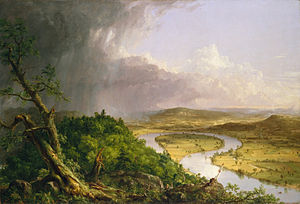All AP Art History Resources
Example Questions
Example Question #31 : Nineteenth Century 2 D Art

What is the quality that most closely echoes the way medieval saints are often represented?
The elaborate brushstrokes
The dynamic patterned background
The vivid blue uniform
The strict symmetry of the figure's head
The gold lettering POSTES on the cap
The gold lettering POSTES on the cap
The dynamic patterned background, elaborate brushstrokes, and vivid color blue are not reminiscent of medieval art, nor is symmetry in and of itself a defining feature. The gold lettering on the figure's cap, however, is similar to the inscription one would use to identify a saint in medieval art.
Image is in the public domain, accessed through Wikipedia Media Commons: https://commons.wikimedia.org/wiki/File:Vincent_van_Gogh_-_Portrait_of_Joseph_Roulin.jpg
Example Question #32 : Nineteenth Century 2 D Art

The spiraling patterns in this painting recall what other Van Gogh painting?
Starry Night
Irises
The Potato Eaters
The Night Cafe
Bedroom in Arles
Starry Night
The pattern of the man's beard and the background resemble the swirling clouds and landscape of Van Gogh's famous Starry Night. The others are domestic scenes with very different textures, except Irises, which is more about vertical movement than spirals.
Image is in the public domain, accessed through Wikipedia Media Commons: https://commons.wikimedia.org/wiki/File:Vincent_van_Gogh_-_Portrait_of_Joseph_Roulin.jpg
Example Question #33 : Nineteenth Century 2 D Art

How does the presence of the steamboat contribute to the painting's theme?
It advances the notion of steam power as the new frontier
It makes the old way of life look hopelessly old-fashioned and ridiculous
It contrasts with the noble, if worn-down, ship it pulls along, suggesting a passage of time
It is intended as a condemnation of the new way of life for being too fast-paced
It highlights the powerful force of industrialization in England at the time
It contrasts with the noble, if worn-down, ship it pulls along, suggesting a passage of time
The painting does not glorify the new world order, nor does it condemn it. Instead, the painting recognizes the new way of life and the need to replace ways that have grown old and stale, but it also recognizes the beautiful sacrifice made by people (and ships) that can no longer offer as much. Thus, it celebrates the fight of the old Temeraire, in spite of its weaknesses now.
Image is in the public domain, accessed through WikiArt: http://www.wikiart.org/en/william-turner/the-fighting-temeraire-tugged-to-her-last-berth-to-be-broken-up-1839
Example Question #33 : Nineteenth Century 2 D Art

The artist's method of painting, in works like this one, was unique in that:
He used oil paint in a translucent way, akin to watercolor
He painted outdoors and did not revise or improve his work after the first session
He used an early form of acrylic paint
He mixed unexpected colors together to produce new hues
He developed thickness through watercolor, akin to oil
He used oil paint in a translucent way, akin to watercolor
None of these are accurate with respect to Turner's work or methodology except for the fact that he used oil in a way more expected of watercolor to create his signature style. This painting is an oil painting, but the texture is surprisingly light.
Image is in the public domain, accessed through WikiArt: http://www.wikiart.org/en/william-turner/the-fighting-temeraire-tugged-to-her-last-berth-to-be-broken-up-1839
Example Question #34 : Nineteenth Century 2 D Art

In The Oxbow (View From Mount Holyoke, Northampton, Massachusetts, after a Thunderstorm), by Thomas Cole, the distinction between the left hand side and the right hand side of the painting highlights the theme of ______________.
a clash between wild nature and civilization
humans harnessing nature's gifts for the benefit of civilization
humans conquering nature by God's providence
nature as a beautiful example of God's gift to humanity
a clash between wild nature and civilization
The Oxbow (View From Mount Holyoke, Northampton, Massachusetts, after a Thunderstorm) is essentially divided between a left side composed of wild vegetation underneath a thunderstorm and a right side featuring farms and villages underneath bright sunshine. Thomas Cole's work sharply contrasts the two sides to show the inherent conflict between nature and civilization in American society in the nineteenth century.
Artwork from Wikimedia Commons: https://commons.wikimedia.org/wiki/File:Cole_Thomas_The_Oxbow_(The_Connecticut_River_near_Northampton_1836).jpg
Example Question #31 : Analyzing Nineteenth Century 2 D Art

Figure 1

Figure 2
The image in Figure 1 conveys __________
madness.
serenity.
certainty.
celebration.
madness.
The figure in The Desperate Man, a self portrait by Gustave Courbet, looks like he is about to leap out of the painting. His eyes are bulging, and he appears to pulling out his hair, all while wearing an ill-fitting shirt. All of this conveys an element of madness in the figure.
Certified Tutor
All AP Art History Resources



